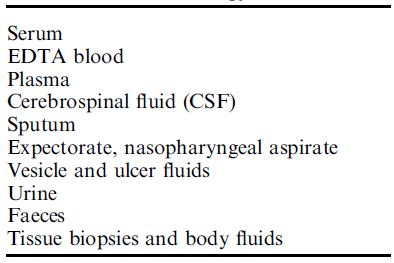
Sample Collection and Nucleic acid Purification
 المؤلف:
John M Walker and Ralph Rapley
المؤلف:
John M Walker and Ralph Rapley
 المصدر:
Molecular Biology and Biotechnology 5th Edition
المصدر:
Molecular Biology and Biotechnology 5th Edition
 الجزء والصفحة:
الجزء والصفحة:
 9-11-2020
9-11-2020
 2096
2096
Sample Collection and Nucleic acid Purification
1 - Sample Collection and Transport
Virtually all human secretions, fluids and tissue samples can be collected and examined for nucleic acids of suspected infectious agents (Table 1). In addition, laboratory cultures, bacterial colonies and infected cell cultures are used for nucleic acid extraction and identification. The microbiological diagnostic laboratory provides kits for taking and shipping patient samples. Some kits contain buffers that inactivate infectious
Table 1 Patients’ samples in clinical microbiology.

agents, inhibit nucleases and lyse membranes to facilitate subsequent nucleic acid extraction. Whenever patient samples are collected and sent without additives, speedy delivery to the laboratory must be ensured and great care must be taken to label the sample appropriately and to avoid contamination of the outside of the collecting vessel. Several companies supply swab kits and buffer kits for stabilising samples during transport. Stool transport and recovery buffer has proved useful for, e.g., faecal
samples (S.T.A.R.; Roche Diagnostics, Indianapolis, IN, USA). The swab extraction tube system (S.E.T.S.; Roche Diagnostics) is a simple kit for rapidly and efficiently recovering specimens attached to and absorbed into the fibres of a collection swab. IsoCode Stix (Schleicher and Schuell, Keene, NH, USA) provides a method for stabilising blood samples that are to be transported long distances for later testing by real-time PCR.
2- Extraction of Nucleic Acids
Different nucleic acid extraction protocols are required for different samples and different microbiological agents. RNA is more susceptible than DNA to rapid degradation by nucleases and the best way to counteract this problem is to dissolve the sample in a guanidinium isothiocyanate-based lysis buffer as soon as possible. Viral nucleic acids usually can be extracted in the same way as host cell nucleic acids are extracted. Sometimes, e.g. for faecal samples, gentle vortexing followed by a low-speed centrifugation can remove debris and viral particles will remain in the supernatant. During subsequent ultracentrifugation, virus particles can be pelleted and concentrated. The thick cell wall of Grampositive bacteria is more difficult to disrupt than the relatively thinner cell wall of Gram-negative bacteria and need special procedures. Haem in blood, bile in stool and components of urine and additives such as heparin may inhibit Taq polymerase and must be removed by the purification procedure prior to the amplification step. Purified nucleic acids should be eluted into a small volume of nuclease-free water or 0.1mM EDTA. Ethanol or propan-2-ol precipitation may be used to achieve smaller volumes, but must be completely removed by pipetting and evaporation to avoid subsequent enzymatic inhibition.
3- Manual Extraction of Nucleic Acids
Several commercial manual extraction kits are available for use by clinical laboratories (see Table 2 in ref. 2). These kits vary in the method, cost and time required for extraction. Processing by manual methods involves a higher risk of contamination and switching of patient samples. US Clinical Laboratory Improvement Amendments of 1988 (CLIA) regulations provide guidelines regarding manual extraction of nucleic acids for diagnostic purposes (http://www.cms.hhs.gov/clia/).
4- Automated Extraction of Nucleic Acids
Automated extraction instruments are manufactured by a number of different companies and, like manual methods, vary in method, cost and time requirements for extraction. Additionally, these instruments vary in the specimen capacity per run and size . Comparisons of manual and automated extraction methods have found automated procedures to be equivalent and in some instances superior to manual methods , although not always. Automated extraction systems have certain inherent advantages over manual methods. Recovery of nucleic acids from automated instruments is consistent and reproducible.
Automated extraction systems keep sample manipulation to a minimum, reducing the risk of cross-contamination of samples. They are most economical when instruments are fully loaded, although smaller and more versatile instruments have now become available. Space and cost of equipment and disposables also need to be considered.
 الاكثر قراءة في مواضيع عامة في الاحياء الجزيئي
الاكثر قراءة في مواضيع عامة في الاحياء الجزيئي
 اخر الاخبار
اخر الاخبار
اخبار العتبة العباسية المقدسة


